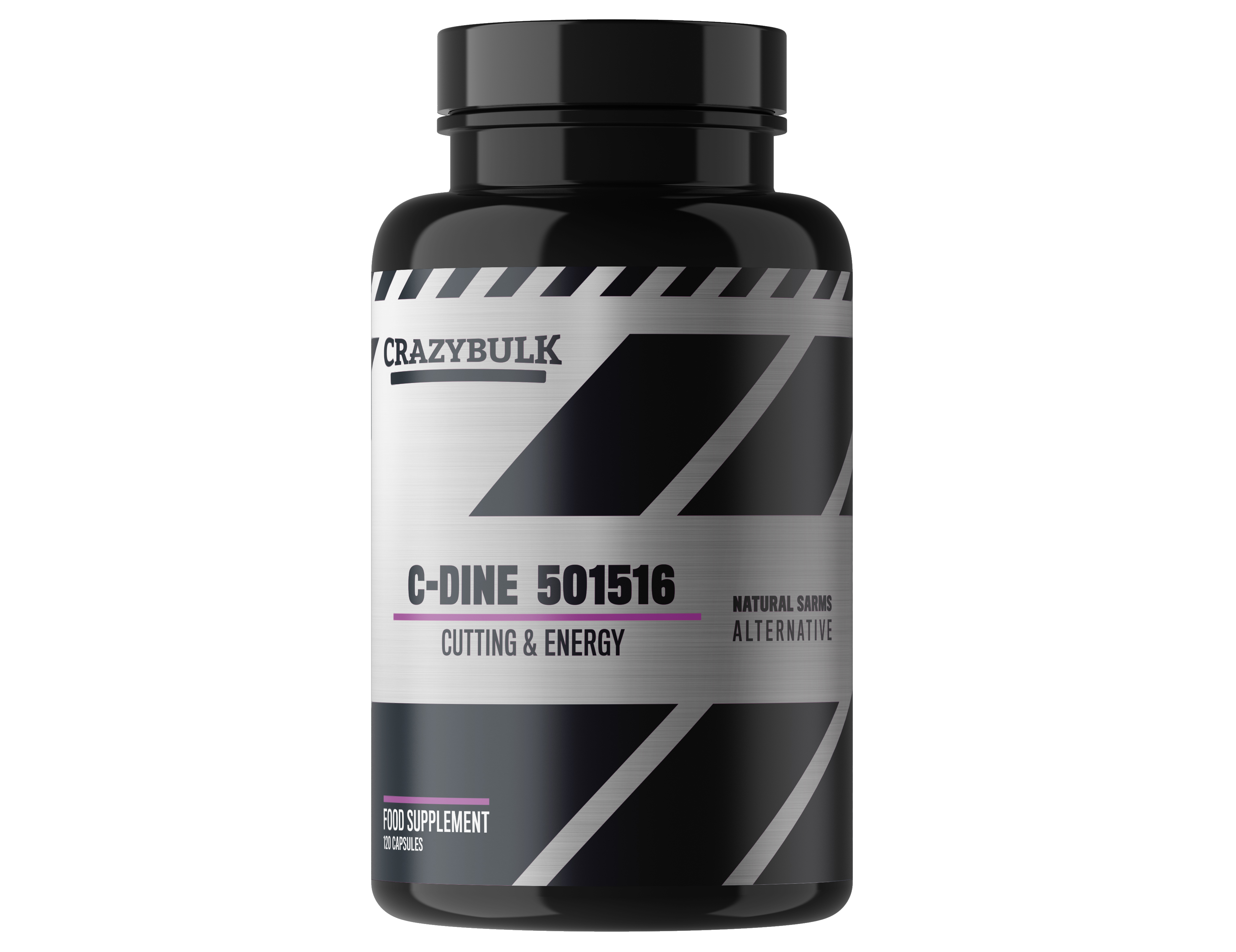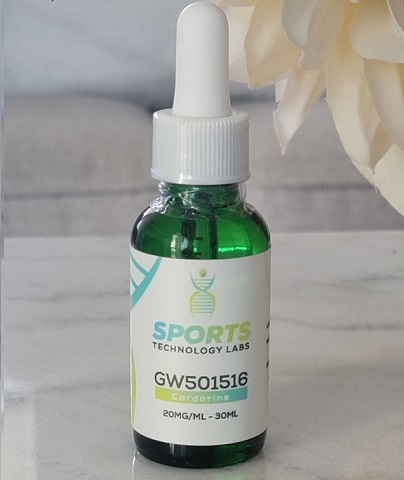Cardarine (GW-501516): Dosage, Side Effects & Before and After Pictures
 Disclaimer: Cardarine is only to be used for research purposes, as it is a non-FDA-approved compound and thus may cause adverse effects. If you have any questions or concerns, Dr. Touliatos is currently available for consultation.
Disclaimer: Cardarine is only to be used for research purposes, as it is a non-FDA-approved compound and thus may cause adverse effects. If you have any questions or concerns, Dr. Touliatos is currently available for consultation.
Cardarine (GW501516) is a PPARD (Peroxisome Proliferator Activated Receptor Delta) receptor agonist. However, it is often referred to as a SARM, due to its similar anabolic and fat-burning effects.
Cardarine was recently formulated in 1992 and thus is classified as a research compound, similar to SARMs, with its effects not yet fully known and unapproved by the FDA.
However, early research has demonstrated cardarine’s positive effects on body composition and athletic performance, causing it to be banned in sports. The World Anti-Doping Agency (WADA) has added cardarine to its list of prohibited substances, placing it in the category of ‘hormones and metabolic modulators’.
Contents
Cardarine’s potent fat-burning effects provide initial promise for the medical community in the treatment of obesity, while weightlifters are already utilizing cardarine to retain muscle mass and enhance fat loss during cutting cycles.
Disclosure: We do not accept any form of advertising on Inside Bodybuilding. We monetize our practice via doctor consultations and carefully chosen supplement recommendations, which have given our patients excellent results.
Best SARMs Company in 2024
Sports Technology Labs (USA)

Sports Technology Labs is our #1 rated source for SARMs in the US, as they consistently formulate products at >98% purity (authenticated via independent certificates of analysis).
Sports Technology Labs also has a 0% credit card fee policy (other sources charge up to 10%).
Maximum discount code (15% off): inside15.
UK SARMs (Worldwide)

For those outside the US, we recommend UKSARMs.com, as they provide excellent stealth shipping worldwide that bypasses customs. Other companies' SARMs often get delayed or seized when shipped internationally.
Thus, UKSARMs are ideal for customers from the UK, Europe, Canada, Australia, and other foreign countries.
Time of arrival: next day (UK), 5-7 working days (worldwide).
Maximum discount code (10% off): inside10.
Is Cardarine Legal?
The FDA has yet to approve cardarine due to safety concerns. Thus, it is illegal to purchase cardarine with the intention of using it on yourself to improve body composition.
However, it is legal to purchase cardarine for ‘research purposes, i.e., administering it to your rat and observing its effects.
Cardarine Benefits
Fat Loss
Cardarine has a positive effect on insulin sensitivity, lipid balance, and glucose tolerance, enhancing lipolysis.
Cardarine stimulates fatty acid oxidation by reducing the utilization of glucose, thus shifting energy metabolism, meaning the body will use fat stores as a primary energy source.
This causes a decrease in both subcutaneous and visceral fat mass in users, producing a leaner and more defined appearance.
Decreases in visceral fat are desirable for users wanting to maintain a small waist, with high levels of visceral fat causing a protruding look to the stomach.
Cardarine’s lipolytic effects are similar to those of certain SARMs used for cutting, such as ostarine.
Anecdotally, we have found that cardarine’s fat-burning properties surpass its ability to build lean muscle tissue.
Cardarine’s positive effects on insulin and blood glucose may result in it being a potential treatment for type II diabetes in the future.
Muscle Hypertrophy
There is evidence of cardarine having a simultaneous anabolic effect, with a phase II study observing an increase in lean mass by 1.3kg in users (1), following a dosage of 10 mg/day for 12 weeks.
This modest increase in muscularity is similar to SARMs, thus having a positive effect, albeit with much less potency compared to anabolic steroids.
Muscle Endurance
We have seen Cardarine dramatically affect muscular endurance due to the remodeling of muscle tissue via mitochondrial biogenesis. Research has shown that cardarine converts faster twitch fibers into slower twitch fibers (2), making users less vulnerable to fatigue during exercise.
Slow-twitch fibers are more efficient at utilizing oxygen due to the presence of mitochondria, enabling superior levels of ATP production (energy) inside the muscle cells.
A study on mice found cardarine to increase endurance by 68% in just 3 weeks (3).
If a user typically performed 30 minutes of cardio before getting tired, a normal experience on cardarine would be for them to now perform 50 minutes of cardio before reaching the same level of exhaustion.
Cardarine’s effects on muscular endurance are quite remarkable, which will also (indirectly) help to burn more fat stores when combined with regular cardiovascular training (due to increased calorie burn).
In our experience, the majority of cardarine’s endurance-boosting results are temporary and will subside when a cycle finishes. However, users are likely to experience superior endurance post-cardarine administration due to muscle memory (the heart is a muscle).
The amount of endurance retained from a cardarine cycle will depend on whether the user continues endurance training post-cycle.
Glycogen Storage
Cardarine increases glycogen storage inside the muscles, so users can experience fuller muscles on-cycle.
This may be of use to bodybuilders or fitness models who require full muscle bellies on stage and are prone to glycogen depletion following calorie-restrictive diets.
Increases in vascularity may also occur due to decreased levels of extracellular fluid.
Improved Cholesterol
Based on our lipid profile tests, cardarine has cardioprotective properties, significantly increasing HDL cholesterol (the good type that you want).
This is a very unique benefit compared to SARMs and anabolic steroids, which can cause negative cholesterol fluctuations.
In the previous phase II cited study, HDL levels increased by 17%, with LDL cholesterol decreasing by 7% with a 10 mg/day dosage.
Thus, stacking cardarine with SARMs or anabolic steroids may not only further enhance body composition and performance but also reduce cardiac risk.
Cardarine’s ability to improve cholesterol may result in it being a potential treatment for dyslipidemia in the future.
Does Not Suppress Testosterone
Anabolic steroids and SARMs decrease endogenous testosterone levels, which is caused by overstimulation of the androgen receptor. However, PPARD agonists do not affect the HPT (hypothalamic-pituitary-testicular) axis, so testosterone levels will remain stable on cardarine with no PCT required.
No Virilization in Women
Cardarine is a suitable compound for women to take in terms of inhibiting masculine side effects. Thus, if females are interested in taking anabolic steroids, or SARMs, with the main intention of losing subcutaneous fat, cardarine may be more optimal in regards to retaining feminine characteristics.
This is due to cardarine not affecting hormones, specifically testosterone, and thus preventing: hair loss, clitoral enlargement, breast reduction, and a deepened voice box.
Although cardarine does not cause masculinization effects in women, it does not mean it is 100% safe for them to take, with it remaining a research chemical. In contrast, anavar is FDA-approved in medicine, with women and children tolerating this steroid well in trials.
We have found anavar causes low incidences of virilization in women when taken in conservative dosages/cycles. Thus, we consider anavar to be a safer compound for promoting significant fat loss (vs. cardarine), due to its effects being well-known and studied over a longer period of time.
Cardarine Side Effects
Cancer
In 2009, cardarine was withdrawn from further development after it produced cancer in all tested dosages, following long-term preclinical safety trials (4).
Tumors were found in the thyroid, liver, bladder, stomach, skin, tongue, uterus, eyes, and testes.
Such trials have been criticized in the fitness community due to excessive dosages and duration of use. However, the lowest dosage given to rodents was 5 mg/kg per day (translated as 65 mg/day for an 80kg human), which also proved to be cancer-causing.
However, a 2-year cardarine cycle, as conducted in the research, surely is excessive compared to the average gymgoer, who typically uses cardarine for 8 weeks.
Note: These tests are standard for safety evaluations, with approved medications passing such requirements.
Liver Toxicity
In phase I and phase II human studies, cardarine demonstrated insignificant fluctuations in ALT and AST liver enzymes at dosages up to 10 mg/day.
However, Dr. Thomas O’Connor has treated patients who have used cardarine and consequently has likened its hepatotoxicity to the equivalent of taking 50 mg/day of anavar (a mega dose).
The reason for conflicting results in research and anecdotal data may be attributed to cardarine causing cellular proliferation. Thus, it stimulates cell growth and division, increasing the overall cell count. This is perfectly acceptable in a healthy person, but in the case of someone with an existing hepatic injury, cardarine may accelerate the death of liver cells (5).
We find cardarine is often taken by individuals who have also taken SARMs or anabolic steroids, which may explain such hepatic complications, as users are often combining cardarine with other hepatotoxic compounds.
Note: Anti-depressants and alcohol consumption may also be a dangerous combination with cardarine.
Thus, if any of our readers are thinking about trying cardarine, we advise getting your liver enzymes tested to better understand the condition of this organ before any potential cellular proliferation occurs.
Insomnia
Some cardarine users report insomnia, indicating a stimulating effect on the central nervous system (CNS) and an increase in adrenaline output.
One method our patients use to avoid this side effect is taking doses earlier in the day (preferably in the morning), thus leaving generous amounts of time for the CNS to regulate before sleep.
Although the CNS may become more aroused, this effect is not believed to be excessive. Thus, cardarine does not replicate the jittery effects of more notorious thermogenic fat burners, such as clenbuterol. Instead, energy levels on cardarine remain stable, preventing any crashes, while also increasing overall well-being in users.
Legal Cardarine Alternative

C-DINE 501516 is our #1 rated legal Cardarine product. It replicates the potent fat-burning and endurance-boosting effects of Cardarine, but without any unwanted side effects.
It is FDA-approved and can be purchased online without a prescription.
C-DINE is best suited for users wanting to burn fat, enhance muscle definition and increase cardiovascular performance simultaneously.
Cardarine Results: Before and After Pictures

This user cycled cardarine for 12 weeks, starting at 10 mg/day for the first week, then 20 mg/day for the remaining 11 weeks.
He lost 40 pounds in weight, going from 205 pounds to 165 pounds, reducing his body fat percentage by approximately 10%.
Cardarine Before and After #2

These before and after pictures are following a 4-week cardarine cycle, with this user administering 10 mg/day.
This man’s results prove that exceptional fat loss is possible, even on a relatively low dosage and short cycle.
He lost 20 pounds and reduced his body fat percentage by approximately 5%.
He also reported notable improvements in cardiovascular performance, occurring from the 3rd week onwards.
Cardarine Dosage
As cardarine (GW501516) has not been approved by the FDA for medicinal purposes, there are no established dosage guidelines. However, in studies, researchers have administered up to 10 mg/day to participants.
Users taking cardarine today for cosmetic purposes typically take 10–20 mg/day. This is taken once per day and approximately 30 minutes before workouts to encourage fat oxidation during exercise.
Cardarine Cycle
Cardarine cycles typically last 6–12 weeks, with dosages ranging from 10–20 mg/day.
Lower dosages (10 mg/day) and short cycles (4 weeks) can still provide exceptional results, as documented in the second before and after transformation.
Note: The higher the dosage and the longer the cycle, the greater the risk of developing cancer.
Ostarine and Cardarine Stack
Cardarine is commonly cycled by itself; however, it can also be stacked with ostarine (MK-2866) for enhanced fat loss.
A typical cardarine and ostarine cycle will look as follows:
- Ostarine: 20mg/day for 8 weeks
- Cardarine: 20mg/day for 8 weeks
Ostarine is considered a cutting SARM due to its fat-burning effects being more prominent than its ability to add lean muscle.
However, we have found ostarine to worsen HDL cholesterol, suppress testosterone, and increase liver toxicity. Thus, a wider range of side effects will occur with the addition of this SARM as opposed to cycling cardarine alone.
Is it a Good Idea to Stack Cardarine?
Due to cardarine’s cellular proliferation ability, it may not be safe to stack it with hepatotoxic compounds, such as SARMs or oral anabolic steroids.
Doing so may exacerbate their adverse effects on the liver, further elevating ALT and AST enzymes and increasing the risk of liver failure.
Short, one-off cycles may present low risk; however, due to a lack of medical research concerning such stacking protocols, it may be wise to avoid them.
How to Take Cardarine

Like SARMs, cardarine often comes as a liquid solution (20 mg/mL) or in tablet form (10mg).
Users can use a syringe to measure out liquid cardarine before placing it in the mouth to swallow.
We have found that taking it sublingually notably increases absorption (6), by letting it sit underneath the tongue for 10-15 seconds before swallowing. This method allows it to come into contact with the mucus membrane, allowing a more direct route into the bloodstream (and thus greater biological availability).
Organizing your workouts earlier in the day may be wise due to cardarine’s stimulating nature. Thus, taking it before your workout, preferably in the morning, will give your central nervous system ample time to wind down before bedtime.
FAQ
What is the Half-Life of Cardarine?
The half-life of cardarine (GW501516) is approximately 12–24 hours.
Should Cardarine Be Taken on an Empty Stomach?
Taking cardarine on an empty stomach does not alter its biological availability; thus, users can take it with or without food.
Summary

Cardarine (GW501516) is a potent fat-burning compound; however, its effects on muscular strength and hypertrophy are minimal in our experience.
Cardarine’s ability to enhance muscular endurance is extraordinary (7), however, it is a prohibited substance by WADA, so athletes run the risk of failing a drug test.
Cardarine remains a research chemical and is unlikely to receive FDA approval due to various dosages causing cancer.
The main reason people buy cardarine today is to burn fat and improve their body composition. However, these two objectives can be achieved naturally with a diligent exercise and diet plan.
Thus, potentially increasing your risk of various cancers by taking this compound could be deemed unnecessary. Eating in a small calorie deficit will produce similar fat-burning and muscle-retaining effects; however, it may take a little longer to reach the same end result.
Co Authors :
References
(1) https://www.ahajournals.org/doi/full/10.1161/ATVBAHA.112.247890
(2) https://pubmed.ncbi.nlm.nih.gov/15328533/
(3) https://www.ncbi.nlm.nih.gov/labs/pmc/articles/PMC4421799/
(4) https://web.archive.org/web/20150504013406/http:/www.toxicology.org/AI/PUB/Tox/2009Tox.pdf
(5) https://www.ncbi.nlm.nih.gov/pmc/articles/PMC3519722/



